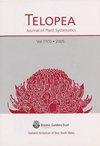Opportunities and challenges presented by cryptic bryophyte species
IF 0.5
4区 生物学
Q4 PLANT SCIENCES
引用次数: 16
Abstract
Cryptic bryophyte species exhibit a decoupling in the degree of morphological and molecular divergence, as a result of different processes, from recent divergence to stasis. Here a body of cryptic species literature comprising 110 papers published between 2000 and end 2018 is reviewed. Most studies of cryptic species focused on northern hemispheric taxa, but we do not yet have sufficient studies to assess whether a geographic bias in the distribution of cryptic species exists, and we don’t know how many cryptic bryophyte species there might be globally. Fully two-thirds of all studies on cryptic bryophyte species rested their claims of morphological crypsis on previous taxonomic investigations, without revision of morphology to confirm cryptic species status. There is more than one kind of morphological crypsis, and while quantification of morphological patterns can contribute to our understanding of crypsis this is a widely neglected component. The usage of ‘cryptic species’ as an etymological tool to flag instances where traditional species concepts are deficient devalues the term, and a distinction between genuine crypsis and business as usual revision of species circumscription should be re-established and maintained. Hybridisation is possibly an under-appreciated contributor to cryptic species, but inference of hybridization has been limited by study design. Opportunities exist in the application of geometric morphometric methods and next generation sequencing technologies to overcome intrinsic limitations in traditional morphological and molecular data sources.隐苔藓植物的机遇与挑战
隐苔藓植物在形态和分子分化程度上表现出解耦性,这是由新近分化到停滞的不同过程的结果。本文回顾了2000年至2018年底期间发表的110篇隐物种文献。大多数关于隐种的研究集中在北半球的分类群上,但我们还没有足够的研究来评估隐种分布是否存在地理偏差,并且我们不知道全球可能有多少种隐苔藓植物。在所有关于隐苔藓植物的研究中,有三分之二的研究是基于以前的分类调查,而没有修改形态学来确认隐物种的地位。形态隐隐不止一种,虽然形态模式的量化有助于我们对隐隐的理解,但这是一个被广泛忽视的组成部分。使用“隐种”作为一种词源学工具来标记传统物种概念不足的实例,降低了术语的价值,并且应该重新建立和维护真正的隐种和通常修订的物种界限之间的区别。杂交可能是隐种的一个未被充分认识的因素,但杂交的推断受到研究设计的限制。几何形态计量学方法和下一代测序技术的应用存在机会,以克服传统形态和分子数据源的内在局限性。
本文章由计算机程序翻译,如有差异,请以英文原文为准。
求助全文
约1分钟内获得全文
求助全文
来源期刊

Telopea
PLANT SCIENCES-
CiteScore
1.30
自引率
42.90%
发文量
0
期刊介绍:
Manuscripts submitted for publication in TELOPEA are published online, after peer review and acceptance by the TELOPEA Editorial Committee and when final editorial formatting has been completed. The journal specialises in plant systematics and phylogeny. The geographic scope of the journal encompasses Australia, Malesia, Melanesia, Micronesia, and Polynesia. The suitability of a work for the journal depends on the topic and the region of origin, generally the narrower the focus of the manuscript the closer to New South Wales must be its geographic focus.
As a general guide, we will consider:
1) revisionary treatments and other substantial bodies of work from any of the regions mentioned above.
2) new species from any Australian state.
3) new country records for Australia from any state.
4) new state records from New South Wales only.
However, we aim to support botanical research across the broader Australasian and Pacific region, and will consider submissions on their merit.
Generally we will not consider extraterritorial new country records, or single lectotypification papers unless they pertain to New South Wales taxa, or have significant bearing on the Australian flora.
 求助内容:
求助内容: 应助结果提醒方式:
应助结果提醒方式:


